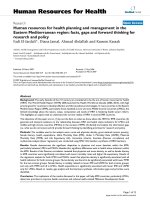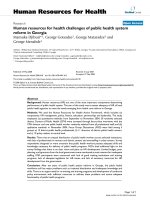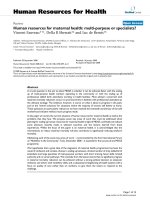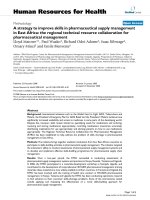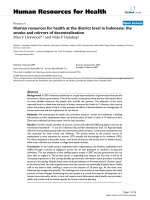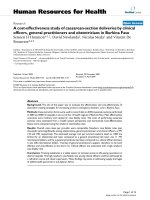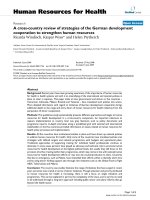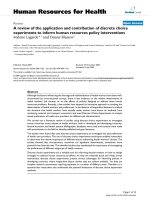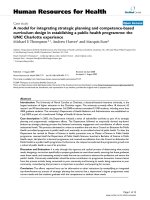báo cáo sinh học:" A model for integrating strategic planning and competence-based curriculum design in establishing a public health programme: the UNC Charlotte experience" doc
Bạn đang xem bản rút gọn của tài liệu. Xem và tải ngay bản đầy đủ của tài liệu tại đây (263.29 KB, 10 trang )
BioMed Central
Page 1 of 10
(page number not for citation purposes)
Human Resources for Health
Open Access
Case study
A model for integrating strategic planning and competence-based
curriculum design in establishing a public health programme: the
UNC Charlotte experience
Michael E Thompson*
1
, Andrew Harver
1
and Marquis Eure
2
Address:
1
Department of Public Health Sciences, The University of North Carolina at Charlotte, Charlotte, NC, USA and
2
Ryan White Program Part
A, Mecklenburg County Health Department, Charlotte, NC, USA
Email: Michael E Thompson* - ; Andrew Harver - ;
Marquis Eure -
* Corresponding author
Abstract
Introduction: The University of North Carolina at Charlotte, a doctoral/research-intensive university, is the
largest institution of higher education in the Charlotte region. The university currently offers 18 doctoral, 62
master's and 90 baccalaureate programmes. Fall 2008 enrolment exceeded 23 300 students, including more than
4900 graduate students. The university's Department of Health Behavior and Administration was established on
1 July 2002 as part of a transformed College of Health & Human Services.
Case description: In 2003, the Department initiated a series of stakeholder activities as part of its strategic
planning and programmatic realignment efforts. The Department followed an empirically derived top-down/
bottom-up strategic planning process that fostered community engagement and coordination of efforts across
institutional levels. This process culminated in a vision to transform the unit into a Council on Education for Public
Health accredited programme in public health and, eventually, an accredited school of public health. To date, the
Department has revised its Master of Science in health promotion into an Master of Science in Public Health
programme, renamed itself the Department of Public Health Sciences, launched a Bachelor of Science in Public
Health major, laid plans for a doctoral programme, and received accreditation from the Council on Education for
Public Health as a public health programme. Furthermore, the campus has endorsed the programme's growth into
a school of public health as one of its priorities.
Discussion and Evaluation: It is only through this rigorous and cyclical process of determining what society
needs, designing a curriculum specifically to prepare graduates to meet those needs, ensuring that those graduates
meet those needs, and reassessing society's needs that we can continue to advance the profession and ensure the
public's health. Community stakeholders should be active contributors to programme innovation. Lessons learnt
from this process include: being connected to your community and knowing its needs, being responsive to your
community, remembering that process is as important as product, and preparing for success.
Conclusion: The efforts reported here can be informative to other institutions by exemplifying an integrated
top-down/bottom-up process of strategic planning that ensures that a department's degree programmes meet
current needs and that students graduate with the competences to address those needs.
Published: 11 August 2009
Human Resources for Health 2009, 7:71 doi:10.1186/1478-4491-7-71
Received: 22 April 2008
Accepted: 11 August 2009
This article is available from: />© 2009 Thompson et al; licensee BioMed Central Ltd.
This is an Open Access article distributed under the terms of the Creative Commons Attribution License ( />),
which permits unrestricted use, distribution, and reproduction in any medium, provided the original work is properly cited.
Human Resources for Health 2009, 7:71 />Page 2 of 10
(page number not for citation purposes)
Introduction
Events of the last decade have sparked renewed public
interest in the process of promoting and protecting the
public's health. Among these concerns is that less than
30% of the public health workforce has formal training in
public health [1], including 75% of the heads of city or
county health departments [2]. This challenge is com-
pounded by estimates that 50% of federal and 25% of
state public health workers will likely retire within the
next five years [2,3].
A number of initiatives address aspects of this complex
issue, including professional development opportunities
for the public health workforce [4-6]; professional creden-
tialling of public health graduates [7] that complements
existing specialty certifications such as the Community
Health Education Specialist (CHES) [8], the Industrial
Hygienist [9] and the Registered Environmental Special-
ist/Registered Sanitarian [10]; evidence-based profes-
sional practice guidelines [11]; and quality assurance and
accreditation mechanisms for public health departments
and related agencies [12-14].
One response to this growing demand for a trained, com-
petent workforce has been the rapid proliferation of pro-
grammes and schools of public health accredited by the
Council on Education for Public Health (CEPH) [15]. As
summarized in Figure 1, the cumulative number of
accredited programmes has nearly tripled over the past
decade.
The number of accredited schools has also increased sub-
stantially, with some, such as those at the University of
Arizona [16] and George Washington University [17],
evolving from accredited public health programmes and
others being created de novo as schools, such as those
launched at Texas A&M University [18] and the University
of Arkansas [19], with several more schools under rapid
development (e.g. the University at Buffalo School of Pub-
lic Health and Health Professions; East Tennessee State
University College of Public Health; the University of
Maryland, Baltimore, School of Public Health) [20-22].
It was within this environment of rapid change, pressing
need and opportunity that the growth and development
of the Department of Health Behavior and Administration
(renamed the Department of Public Health Sciences in
May 2007) within the College of Health and Human Serv-
ices at the University of North Carolina at Charlotte (UNC
Charlotte) coalesced. UNC Charlotte, a doctoral/research-
intensive university, celebrated its 60th anniversary in
September 2006. It is the fourth-largest of the 17-constit-
uent University of North Carolina system and the largest
institution of higher education in the Charlotte region.
The university comprises seven professional colleges and
currently offers 18 doctoral programmes, 62 master's
degree programmes and 90 programmes leading to bach-
elor's degrees. Fall 2008 enrolment exceeded 23 300 stu-
dents, including more than 4900 graduate students.
The expansion of UNC Charlotte's graduate programmes
in the past 10 years as well as the fortuitous location of the
university (in a city where the health care industry is one
of the area's largest employers [23] and within a county
that is home to the state's largest health department [24])
contributed to a major restructuring of the former College
of Nursing and Health Promotion into the College of
Health and Human Services in 2002. The new College was
proposed in a summary report submitted to the Provost
on 26 November 2001, after several years of related activ-
ities, including: review during the 2002–2007 academic
planning cycle of the Report of the Health Commission
(submitted on 10 July 2000); a campus-wide conversation
surrounding "behavioral health" (held in Spring 2001);
and, a consensus recommendation by the Task Force on
Behavioral Health (delivered on 1 October 2001) [25].
The final proposal included the formation of a School of
Nursing, transfer of the Department of Social Work from
the College of Arts & Sciences, and a restructuring of the
former Department of Health Promotion and Kinesiology
into two separate units, the Department of Health Behav-
ior & Administration and the Department of Kinesiology.
On 22 March 2002, the UNC Charlotte Board of Trustees
approved implementing a range of strategic initiatives
related to the establishment of the College of Health and
Human Services. In time, new priorities emerged from
these combined efforts, including the development of
CEPH accredited schools and programmes by decade of ini-tial accreditation (cumulative) Source:
, July 2009Figure 1
CEPH accredited schools and programmes by decade of ini-
tial accreditation (cumulative) Source: http://
www.ceph.org, July 2009.
0
20
40
60
80
100
120
140
1940s 1950s 1960s 1970s 1980s 1990s 2000s
N (cumulative
)
Schools
Programs
TOTAL
Human Resources for Health 2009, 7:71 />Page 3 of 10
(page number not for citation purposes)
graduate and undergraduate public health degree pro-
grammes, CEPH accreditation and plans for a school of
public health.
Case description
Like many institutions, the University of North Carolina
system engages in an interactive and iterative systematic
strategic and action planning process [26]. Through criti-
cal assessment of data, input from higher and lower
administrative units and inputs from stakeholders and
others in the external environment, each unit develops a
mutually reinforcing strategic and action plan [27-29]. At
the department and programme level, the iteration of this
strategic planning process involved the classic SWOT
(strengths, weaknesses, opportunities and threats) analy-
sis leading to changes in mission and priorities (Figure 2).
These decisions, in turn, precipitate a top-down/bottom-
up planning and action cycle (Figure 3). The top-down
portion reflects the mandates and expectations imposed
on the department from higher units within the university
system as well as external stakeholders such as accrediting
bodies, employers and students. When reaching the fac-
ulty level, these tasks become distributed among a
number of evidence-gathering and consensus-building
efforts, both internal and external.
The empirically derived top-down/bottom-up cycle will
be described concurrently with its application to this case.
While presented linearly, the process, in reality, is iterative
and cross-linked throughout. Information and ideas gen-
erated at one step may require revisiting decisions made in
earlier steps before resuming the process. Likewise, many
of these process steps are pursued simultaneously (by dif-
ferent or the same individuals) and information is shared,
allowing for ongoing self-informing and self-correcting
activities.
Top-down
While not always well stated or made explicit, the process
employed in the Department has, more or less, followed
this concurrent top-down/bottom-up strategic planning
approach.
Assess and align mission
The newly created Department of Health Behavior and
Administration was charged with administering two exist-
ing graduate degree programmes (Master of Science in
Health Promotion and Master of Health Administration),
several Certificate programmes, and an Interdisciplinary
Health Studies undergraduate minor. During its first year,
the Department's research, teaching and service agendas
converged into a focused and integrated vision under the
theme "public health and health behaviour outcomes
from a social-ecological perspective."
By design, the Department had been organized as an
interdisciplinary unit intended to overcome the often arti-
ficial, discipline-specific barriers to research and academic
programming [30]. Consequently, the new Department
was uniquely positioned to examine a wide range of pos-
sible goals, initiatives and programmes in light of its new
environment.
The process started by simultaneously examining faculty
strengths, community priorities and explicit university
and college goals [31] to frame discussions that began at
the unit's first retreat in Spring 2002. The university had
recently dedicated itself to transforming from a compre-
hensive university to a research-oriented university. The
newly conceived College of Health and Human Services
was perceived as a potential leader in establishing a thriv-
ing research base that emphasized population health and
health behaviour research while generating responsive
and progressive health and human service training pro-
grammes. The development of the Department's mission
was quickly synchronized with the institution's rapid
growth, the rich resources of the Charlotte-Mecklenburg
region, and national trends evident, for example, in recent
Institute of Medicine reports [32,33].
Assess needs
The faculty initiated a detailed needs assessment. This
assessment process drew upon prior needs assessments
and related information collected during the formation of
the new College of Health and Human Services. The
SWOT analysis catalogued many of the region's existing
health resources and the significant contribution of health
and human services to the local economy. The analysis
documented that Charlotte was one of the largest United
States cities not served by either a school of medicine or a
school of public health [34].
Hierarchy of mutually reinforcing strategic and action plansFigure 2
Hierarchy of mutually reinforcing strategic and
action plans.
Internal EnvironmentExternal Environment
University strategic & action plans
College strategic & action plans
Department strategic & action plan
University System strategic & action plans
Faculty & committee plans & actions
Public mandates
Demonstrated need
Projected need
Competing priorities
Community support
Stakeholder support
Employer/Student interest
Fiscal/other constraints
Human Resources for Health 2009, 7:71 />Page 4 of 10
(page number not for citation purposes)
Consult stakeholders
A seminal community roundtable was held in 2003, with
representation from a broad spectrum of stakeholders
from professional practice (both governmental and non-
governmental), academic and community settings.
Guided by a professional facilitator, three key themes
emerged from this roundtable. First, there was broad sup-
port for reorienting the existing MS in Health Promotion
from a focus on health education and worksite wellness
into a broader public health degree.
The Master of Science in Public Health (MSPH) emerged
as a favoured idea over the Master of Public Health (MPH)
because of the expressed need for competent practitioners
versed in research methods and translation of research
findings into programmatic activity. The practitioners
from the community, operating in an environment facing
the pressures of evidence-based practice, translational
research, imminent accreditation of public health agen-
cies and the likely credentialling of public health practi-
tioners, strongly supported the "S" in MSPH, believing
that the combination of letters conveyed their desired
emphasis on both the practice of public health and the
science of public health research. Stakeholders further
suggested that offering the MSPH might serve to distin-
guish the programme from public health programmes
available in the region.
Second, there was broad support to expand the focus of
the department beyond health behaviour and administra-
tion into all public health disciplines and to establish
undergraduate and doctoral programmes in public health
that would serve the needs of state and local agencies and
allow the programme to grow into a full-fledged school of
public health. The third recommendation was that the
Department institutionalize and nurture its new-found
connection to the practice community through the estab-
lishment of an advisory board.
Examine professional standards/norms
In considering the academic and resource implications of
these stakeholder recommendations, the Department
sought advice from other academics and invited a consult-
ant from CEPH to review the existing programme and
Top-down/bottom-up strategic planning processFigure 3
Top-down/bottom-up strategic planning process.
Top-down
1. Assess and align mission
• Examine the unit’s mission within the context of the units above and
below
2. Assess needs
• Conduct a SWOT analysis
3. Consult stakeholders
• Gather input from external stakeholders, specific to program and
department and to larger university and practice communities
4. Examine professional standards/norms
• Examine accreditation and licensing requirements and trends
• Examine efforts of peer institutions
5. Prioritize within constraints & imperatives
• Assess consensus priorities within existing resources and
potential to generate needed resources
• Assess consensus priorities with externally imposed imperatives &
overarching mission and vision
• Develop specific priority goals
• Revisit/revise mission if warranted
6. Set primary goals/objectives
– Graduates
• Define the goals for program graduates
– Program
• Define the program’s academic goals and primary objectives
7. Specify educational strategies/approaches
• Define key educational strategies and approaches needed to achieve
program goals
• Provide guidance in the specification of the curriculum
8. Establish processes for defining, assessing & revising
curriculum
• Provide structure for the continuing definition, assessment, and
revision of the curriculum
• Consider integration/coordination with existing programs and
procedures
• Assign responsibility for program and its implementation
Bottom-up
14. Reassess goals
• Validate that the goals are correct
• Validate that the program is meeting those goals
• Ensure program is integrated into unit and institution
13. Align competencies and student assessment methods
– Curriculum design
• Ensure the curriculum design promotes effective student assessment
• Ensure the curriculum design is consistent with the stated program
objectives and s meeting the identified need
– Student assessment
• Ensure assessment methods are consistent with the nature of the
stated competency
• Ensure capstone, theses, practica, and other integrative assessments
are sufficiently rigorous, sufficiently comprehensive, and sufficiently
flexible
12. Relate curriculum to competencies
• Ensure that the curriculum provides learning and assessment
opportunities for all competencies and that any redundancies are
planned and necessary
• Ensure that learning opportunities are appropriately sequenced
11. Define the curriculum
• Partialize and sequence the content of the program into discrete units
(activities, courses, modules, tracks, etc)
10. Select an organizing framework/paradigm
• Based on program competencies and other factors, select an
organizing principle or philosophy that binds the program into a
coherent curriculum (e.g., professional practice process, research
process, or other professional paradigm)
• Define congruent learning methods and sequences (e.g., problem-
based learning, experiential learning, lock-step sequences)
9. Define competencies needed to ensure program graduates
meet expectations
• Use program goals, professional norms, accreditation criteria, and
stakeholder suggestions to define the competencies needed by a
program graduate
• Organize these competencies into discrete units and develop a
means of organizing and presenting them
• Provide a conceptual roadmap to the program and its objectives that
will guide further development of the curriculum as well as inform and
educate students and stakeholders
Human Resources for Health 2009, 7:71 />Page 5 of 10
(page number not for citation purposes)
comment on what was needed to pursue accreditation as
a public health programme. This visit occurred as CEPH
was in the process of revising its criteria; the discussion
focused on planning to meet the likely new criteria [35].
Several content and procedural shortcomings were identi-
fied, including lacking well-formed internship and cap-
stone activities, requiring too few credits and having
several gaps in the required curriculum. The lack of for-
mally trained public health faculty in sufficient numbers
and disciplinary diversity to merit accreditation also was
noted.
Prioritize within constraints and imperatives
With this information in hand and a positive assessment
of support within the college and university administra-
tion, the Department began planning to implement the
community roundtable's three recommendations. Imple-
menting these recommendations involved a set of plan-
ning activities for faculty and administrators alike. Those
deliberations, in turn, stimulated iterative efforts between
the college, the university and external stakeholders to
generate additional information, clarify and develop a
shared vision and identify issues for further deliberation
and future consideration.
In 2003, planning commenced to implement the first rec-
ommendation: to transform the MS in Health Promotion
to a CEPH-accreditable MSPH programme. The Depart-
ment identified the faculty and other resources needed to
implement the new programme and a coordinator for the
new programme was recruited, as were other faculty. Con-
sensus for the direction and focus of the new MSPH
emerged. Acting on the second recommendation – to plan
for a school of public health – would require more time
and would need to await the arrival of additional public
health-trained faculty. The third community recommen-
dation – the establishment of an advisory board – was
immediately implemented. The newly created Public
Health Advisory Board reflected an intentional mix of
leaders from local health departments, large health care
organizations and wellness-oriented community agen-
cies.
Set primary goals/objectives
Based on these development priorities, two mandates
emerged: hire more faculty, emphasizing those with train-
ing in core public health disciplines; and begin the com-
plex academic planning and curriculum development
process. In 2005, the department of five full-time faculty
members doubled with the addition of three junior fac-
ulty members as well as two senior faculty members with
institution-wide responsibilities. Two more faculty mem-
bers joined these ranks in 2006, four in 2007 and three in
2008, with two more expected for the 2009/2010 aca-
demic year.
With this growing cadre of faculty, work on the planning
and implementation of these degree programmes moved
forward with increasing speed. Academically, the first
order of business was to reshape the existing MS in Health
Promotion into an MSPH programme. A detailed curricu-
lum proposal and justification, building on the material
collected as part of the SWOT analysis and the community
roundtable, was presented to the university governance
for approval. Concurrently, students in the soon-to-be-
supplanted MS programme were advised of the planned
changes and involved in the transition process.
Specify educational strategies/approaches
The goals of the new MSPH required an integration of
professional practice and research competence within a
45-credit, 21–28-month programme. These objectives
dictated an intensive academic programme comple-
mented by practical learning in both field and research/
development settings. Educational strategies appropriate
for the specific disciplines and courses were recom-
mended, with careful attention to cross-cutting and cap-
stone activities.
Establish processes for defining, assessing and revising
curriculum
While the university and college had established processes
for reviewing and approving curricula, the Department,
due to its heretofore small size, had always acted as a
"committee of the whole" with minimal oversight of the
faculty responsible for coordinating specific programmes.
The department's expanding faculty complement and
portfolio of programmes necessitated the formation of a
departmental curriculum committee (consisting of the
coordinators of the various programmes) supported by ad
hoc faculty advisory committees for each programme. The
ad hoc committees were replaced in Fall 2007 with the
newly formed Public Health Programs Governance Com-
mittee and expanded in Fall 2008 to include programme-
specific support committees. This model provided the req-
uisite support and oversight to speed and improve the
quality of the tremendous amount of academic planning
needed to implement and administer these programmes.
Bottom-up
With the specific tasks for the faculty defined in terms of
key objectives and features, the bottom-up portion of the
process commenced.
Define competences
As the curriculum proposal to revise the MS in Health Pro-
motion into an MSPH moved through the university gov-
ernance system, efforts were initiated to more explicitly
define the competences and assessment methods needed
to ensure that the totality of the curriculum provided what
was needed to produce competently trained graduates.
Human Resources for Health 2009, 7:71 />Page 6 of 10
(page number not for citation purposes)
Sources such as the Association of Schools of Public
Health (ASPH) competence project as well as compe-
tences developed by other schools and programmes were
consulted [36,37]. These ideas, as well as those coming
from the faculty and the advisory board, were adapted to
the specific mission, vision and circumstances of the UNC
Charlotte community. Consensus emerged about the
optimal capabilities and preparation of a UNC Charlotte
MSPH graduate, the most appropriate conceptual model
for organizing and depicting the competences and the
type of student the programme should target [38].
Select an organizing framework/paradigm
An examination of the UNC Charlotte MSPH competence
listing in combination with reviewing the approaches of
other MSPH and MPH programmes led to an organiza-
tional approach that mirrors the MSPH programme's dual
emphasis on research and practice. The 45-credit curricu-
lum (requiring two to two-and-a-half years of full-time
study) was organized such that students concurrently fol-
low a professional practice (problem-solving) sequence
integrated with a research process sequence: students are
exposed to epidemiology and biostatistics concurrently
with research methods; and to behavioural and environ-
mental determinants of health concurrently with pro-
gramme planning and programme evaluation.
The sequence first delivers the core curriculum (expanded
beyond that typical of MPH programmes) followed by
courses designed to facilitate the integration and applica-
tion of the new knowledge and skills in both practice and
research contexts (Figure 4). The practicum develops com-
petence in professional practice. The capstone thesis or
project develops student competence in applying research
skills through mentored research (thesis) or evidence-
based public health practice (project) experiences that
result in a scholarly paper appropriate for an academic or
professional audience. These core training experiences are
coupled with coursework that develops greater depth of
knowledge within a given area. Coordination efforts
ensure that classes appropriately address both practice
and research implications of contemporary public health
topics.
Define the curriculum
Meshing the delivery of these competences into the organ-
izational approach for the MSPH programme led to a val-
idation (with minor tweaking) of the revised core and
focal area curricula [39]. Course content was organized
and sequenced to provide to students the requisite com-
petence to be successful graduates, where success is
defined by the community's stated needs and expectations
and by evolving professional standards (e.g. employer
type and employment rates, pass rates on credentialling
examinations, competitiveness for doctoral programmes
and contributions to professional practice).
Relate curriculum to competences
A concurrent process to organizing the competences into
a coherent curriculum of courses and learning experiences
was the development of a matrix to ensure that students
were indeed provided training on and were assessed for
mastery of all the explicit competences. The curriculum-
competence matrix ensured there were no areas where
competence was expected without a defined (formal or
informal) training opportunity. Likewise, the matrix
helped identify areas where competences might be better
sequenced or where explicit course prerequisites were
needed to ensure students had acquired basic competence
before more advanced skills were taught. This review also
helped ensure that any duplication of competence was
planned reinforcement and review rather than unin-
tended redundancy.
Once completed with the core of the MSPH, the process
was extended to its focal areas (somewhat akin to a con-
centration or track), then to the planned BSPH major.
This planning process is now integrated as a routine part
of the Department's curricular planning activities.
Align competences and student assessment Methods
Once assured that the curriculum was providing the req-
uisite competences and that these competences were
being formally assessed, attention shifted to the assess-
ment methods themselves. Assessment methods naturally
reflect the traditions of the various disciplines that com-
prise public health. Methodological disciplines such as
epidemiology and biostatistics typically use problem-
based exams and case studies, while behavioural sciences
often use essay-based and oral examinations and profes-
sional programmes rely on internships, capstone experi-
ences and other practical demonstrations. Far too often,
UNC Charlotte MSPH curriculumFigure 4
UNC Charlotte MSPH curriculum.
Traditional MPH core
Social and Behavioral Foundations of Public Health
Community Epidemiology
Public Health Data Analysis (biostatistics)
Environmental Health
Health Services Administration
Internship & Capstone
Expanded core for UNC Charlotte MSPH
Public Health Research Methods
Community Health Planning and Evaluation
Research and Thesis in Public Health or
Public Health Project
Community Health Concentration (mix of research and practice)
Health Behavior Change
Community Health
Methods in Community Health
Human Resources for Health 2009, 7:71 />Page 7 of 10
(page number not for citation purposes)
administrative ease or a lack of understanding results in
inappropriate assessment tools being used for a given sit-
uation [40] (i.e. it is exceedingly difficult to assess a stu-
dent's ability to critically synthesize and apply knowledge
in a "real world" situation by means of a multiple-choice
exam).
Ensuring congruence between a competence and its
assessment tool, therefore, requires concerted effort on
the part of the faculty to examine assessment at both a
course and a programmatic level: it may be fine to assess
only a student's ability to calculate a chi-square statistic on
a biostatistics end-of-class exam if the student will have to
demonstrate the ability to determine which statistics are
appropriate for a given set of data elsewhere in the curric-
ulum. Integration, application and practice objectives are
one area where practica and capstones (theses or projects)
can serve a critical catch-all role, in much the same way as
qualifying exams for doctoral students. External assess-
ments, such as student performance on credentialing
exams such as the CHES (Certified Health Education Spe-
cialist) or the newly launched CPH (Certified in Public
Health), can also provide timely feedback on the ade-
quacy of a programme's preparation of its graduates [7,8].
Reassess goals
As the bottom-up portion of the process reaches its con-
clusion, the information gathered during the prior steps
then feeds back into the assessment of the mission, to
begin the next iteration of the cycle. The first task was to
ensure that what emerged from the cycle adequately
responded to the needs generated by the top-down proc-
ess. Course, exit, employer and alumni surveys and other
assessments provided useful and timely feedback that
informed programmatic change. When deviations in the
articulation between the processes were identified, the fac-
ulty determined how best to reconcile these differences
and assess whether the deviation were due to flaws in the
application of the process or reasoned responses to an
ever-changing environment. Identification of new threats
and opportunities is a useful by-product of this process,
and one that often stimulates new and innovative lines of
inquiry that will in turn stimulate new directions in the
strategic assessment.
The first iteration of the process at UNC Charlotte led to
changes in the sequencing of core courses (to better sup-
port students as they now begin to engage in their thesis
project in parallel to their coursework) and to end the
cross-listing of two core courses (to provide a smaller class
size and a greater focus on the specific needs and interests
of public health students). At a faculty level, this process
also led to a commitment to work toward dual CAHME
(Commission on Accreditation of Healthcare Manage-
ment Education) and CEPH accreditation of the Depart-
ment's MHA programme as one part of the larger initiative
to evolve toward status as a school of public health.
This expanded vision of public health offerings at UNC
Charlotte has been shared with the University Administra-
tion and is now being shaped through a participatory
stakeholder process, restarting the cycle of strategic plan-
ning and engagement that brought the Department to this
point. In autumn 2008, growth of the UNC Charlotte
Public Health Programs into a school of public health
emerged as one of the campus's priorities during the UNC
system-wide "UNC Tomorrow" strategic planning process
[41].
Discussion and Evaluation
It is only through this rigorous and cyclical process of
determining what society needs, designing a curriculum
specifically to prepare graduates to meet those needs,
ensuring that those graduates meet those needs and reas-
sessing society's needs that we can continue to advance
the profession and ensure the public's health. In the case
of the Department of Public Health Sciences at UNC
Charlotte, the most recent cycle has been transforma-
tional and exceptionally fast.
As summarized in Figure 5, the Department has had a
string of rapid successes and ambitious plans for attaining
status as a school of public health in the next decade.
Notable achievements include the graduation of the first
MSPH class in the spring of 2006, designation of attaining
school of public health status as a campus priority in Fall
2008, graduation of the first BSPH class in the spring of
2009 and awarding of initial CEPH accreditation as a pub-
lic health programme in June 2009.
This rapid progress was made possible by the strategic
allocation of human and capital resources from across the
university and by the stakeholder support for student
internships and other facets of the programme that relied
on community engagement. This campus and community
support was itself a product of these strategic planning
efforts that had defined, justified and effectively conveyed
the value of these initiatives to key decision-makers at crit-
ical times in the planning process.
Conclusion
By following and trusting the process, UNC Charlotte has
made great strides in a short time. The programme is by
no means assured of success and cannot claim that it is a
model worthy of emulating other than by these short-
term successes. Still, several lessons have emerged thus far.
These lessons are not new or innovative, but they bear
repeating:
• Be connected to your community.
Human Resources for Health 2009, 7:71 />Page 8 of 10
(page number not for citation purposes)
Achievements and projected timelineFigure 5
Achievements and projected timeline.
1995 MHA first offered
1997 MS Health Promotion first offered
2002 CHHS formed
HBA formed
Dept of Kinesiology formed
Dept of Social Work moves from College of Arts & Sciences
School of Nursing restructured
2002 HBA strategic planning launched
2003 Community roundtable held
Clear voice for graduate and undergraduate public health education
Clear voice for graduates versed in both practice and research
Clear voice for sustained linkage to practice community
2004 CEPH consultant invited to campus
Public Health Advisory Board created
Focused recruitment of public health trained faculty begins
2005 MS in Health Promotion transformed into MSPH
Competencies developed
Curriculum revised
MSPH Admissions Committee constituted
College launches first doctoral degree (Health Services Research)
CEPH workshop on new accreditation criteria offered at APHA Annual Meeting
Vision to become a School of Public Health articulated
Planning to offer BSPH begun
2006 First MSPH graduates
Application made to CEPH for accreditation as a public health program
First MSPH student handbook prepared
First MSPH handbook for theses, projects and internships prepared
Preparations made to implement BSPH begin
Planning for PhD in Public Health (behavioral sciences) started
2007 Formal CEPH consultation (as part of accreditation process)
Department changes name to Department of Public Health Sciences
BSPH launched
Public Health Programs Governance Committee established
MHA program receives initial (3 year) CAHME accreditation
Initial roundtable meeting to explore developing a school of public health
2008 Proposal to offer PhD in Public Health (Behavioral Sciences) submitted
Second roundtable meeting to explore developing a school of public health
CEPH self study submitted
CEPH site visit
2009 First BSPH graduates
CEPH Accreditation (program) conferred
Planning to offer PhD in Public Health (epidemiology) started
PROJECTED (2010 and beyond)
MSPH offerings expand
MHA curriculum revised toward dual CAHME and CEPH accreditation
PhD in Public Health (Behavioral Sciences) launched
PhD in Health Services Research curriculum revised to meet CEPH criteria
Faculty and student numbers continue to increase
Offerings and programs continue to expand to meet CEPH criteria as a School of Public Health
Department renamed as a School of Public Health
Accreditation sought as a change in status to a School of Public Health
School joins ASPH as Associate Member
Accreditation as School of Public Health conferred
Human Resources for Health 2009, 7:71 />Page 9 of 10
(page number not for citation purposes)
• Know your community and its needs.
• Be responsive to your community.
• Build coalitions by building consensus.
• Remember that in the long run, process is as important
as product.
• Plan inclusively and effectively.
• Recognize and seize opportunities.
• Prepare for success.
The adaptable, empirically derived, top-down/bottom-up
strategic planning process described here provides a struc-
tured, comprehensive and inclusive process for ensuring
that these lessons are grounded into organizational prac-
tice.
It is a constant challenge to keep advancing on all the
fronts needed to meet this new vision for the future while
ensuring that the infrastructure and community support
are in place. It is a delicate balance between moving too
quickly and making costly errors versus moving too
slowly and losing critical momentum and public support
or missing out on opportunities entirely. This dilemma is
captured by the new buzzword in urban development:
'smart growth'. The challenge we face as academic and
professional programmes in public health is growing as
quickly as possible to meet the vast unmet community
need, but in a way that ensures the sustainability, effec-
tiveness and efficiency of the programme. Following a
strategic planning, community engagement and curricular
design process such as the one outlined above is one
means to ensure that curricula are responding to a com-
munity's needs and ultimately improving the public's
health.
Competing interests
The authors declare that they have no competing interests.
Authors' contributions
MET conceived of the paper and its organizing principles;
AH & MET implemented the strategic planning process
described in the paper; ME, a practitioner stakeholder,
guided the conceptualization and implementation of the
process and assisted with the analysis and interpretation
of the results. All authors read and approved the final
manuscript.
Acknowledgements
This work was supported, in part, by funds provided by the University of
North Carolina at Charlotte.
References
1. US Centers for Disease Control and Prevention: Public health's
infrastructure: A status report. Atlanta 2001.
2. The Council of State Governments, Association of State and Territo-
rial Health Officers, National Association of State Personnel Execu-
tives: State public health employee shortage report: A civil
service recruitment and retention crisis. Washington, DC 2004.
3. Partnership for Public Service: Homeland insecurity: Building
the expertise to defend America from bioterrorism. Wash-
ington, DC 2003.
4. What is PHTN? The history [ />tory.asp]
5. Public Health Training Centers [ />public.htm]
6. Public Health Functions Project: The public health workforce: An
agenda for the 21st Century. Washington, D.C.: US Department
of Health and Human Services; 1998.
7. About the NBPHE [ />]
8. CHES Exam Eligibility [ />]
9. General Information [ />]
10. Registered Environmental Health Specialist/Registered San-
itarian (REHS/RS) [ />index.shtml#rehsrs_cred]
11. Anderson LM, Brownson RC, Fullilove MT, Teutsch SM, Novick LF,
Fielding J, Land GH: Evidence-based public health policy and
practice: Promises and limits. American Journal of Preventive Med-
icine 2005, 28:226-230.
12. National Public Health Performance Standards Program
[ />]
13. Exploring Accreditation [ />]
14. North Carolina local health department accreditation
[ />]
15. Accredited Schools & Programs of Public Health [http://
www.ceph.org/i4a/pages/index.cfm?pageid=3344]
16. Milestones [ />stones.aspx]
17. Program Overview [ />grams/programs/joint_and_special_pub/PA_MSHS_MPH.pdf]
18. Message from the Dean [ />the-dean/deans-message.html]
19. A Message from the Dean [ />]
20. Regents give public health school approval [http://
www.sph.umaryland.edu/]
21. SPHHP Seeking Accreditation from CEPH [
falo.edu/sitevisit/index.php]
22. Accreditation [ />]
23. Largest Employers [n-
dex.php?submenu=LargestEmployers&src=g endocs&ref=Larg
estEmployers&category=Business_Profile]
24. Mecklenburg County Health Department [http://
www.charmeck.org/Departments/Health+Department/Home.htm]
25. Health Commission: Report of the Health Commission: A stra-
tegic plan for 2000–2010. Charlotte, N.C.: University of North
Carolina at Charlotte; 2000.
26. The University of North Carolina Board of Governors: Long range
plan: 2004–2009. 2004.
27. University of North Carolina at Charlotte: Institutional Plan
2004–2009. Charlotte, NC 2004.
28. College of Health and Human Services: Strategic plan 2002–2009.
Charlotte, NC: University of North Carolina at Charlotte; 2002.
29. Department of Health Behavior and Administration College of Health
and Human Services: Academic plan 2005–2010. Charlotte, NC:
University of North Carolina at Charlotte; 2005.
30. Lead, follow, get out of the way: Sidestepping thebarriers to
effective practice of interdisciplinarity [rid
vigor.net/interdis/pubs/hv_pub_interdis-2001.04.30.pdf]
31. Goals of Academic Affairs [ />sPlanning/goals.htm]
32. Gebbie K, Rosenstock L, Hernandez LM, The Institute of Medicine
(Eds.): Who will keep the public healthy? Educating public
health professionals for the 21st Century. Washington, D.C.:
National Academies Press; 2003.
Publish with BioMed Central and every
scientist can read your work free of charge
"BioMed Central will be the most significant development for
disseminating the results of biomedical research in our lifetime."
Sir Paul Nurse, Cancer Research UK
Your research papers will be:
available free of charge to the entire biomedical community
peer reviewed and published immediately upon acceptance
cited in PubMed and archived on PubMed Central
yours — you keep the copyright
Submit your manuscript here:
/>BioMedcentral
Human Resources for Health 2009, 7:71 />Page 10 of 10
(page number not for citation purposes)
33. Field MJ, Tranquanda RE, Feasley JC, The Institute of Medicine:
Health services research: Workforce and educational issues.
Washington, D.C.: National Academies Press; 1995.
34. Garlock K: Carolinas HealthCare explores deal with UNC:
Board approves study on possible branch campus in Char-
lotte. Charlotte Observer. Charlotte, NC 2007.
35. Council on Education for Public Health: Accreditation criteria:
Public health programs, amended June 2005. Washington, D.C
2005.
36. MPH Core Competency Development Project [http://
www.asph.org/document.cfm?page=851]
37. Johns Hopkins University School of Hygiene and Public Health: MPH
student handbook. Baltimore, MD 1999.
38. UNC Charlotte Department of Health Behavior & Administration:
Conceptualization of the MSPH Program: Core competen-
cies. 2006.
39. Master of Science in Public Health (MSPH) [
lichealth.uncc.edu/
index.php?option=com_content&task=view&id=33&Itemid=58]
40. Tekian A, McGuire CH, McGaghie W, (Eds.): Innovative simula-
tions for assessing professional competence: From paper
and pencil to virtual reality. Chicago, IL: University of Illinois at
Chicago Department of Medical Education; 1999.
41. University of North Carolina at Charlotte: UNC Tomorrow:
Phase 1 Response. Charlotte: University of North Carolina at
Charlotte; 2008.
